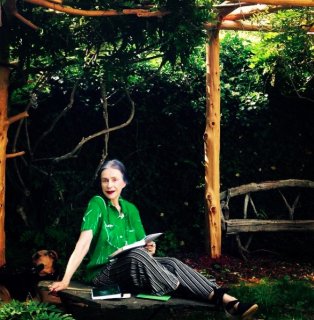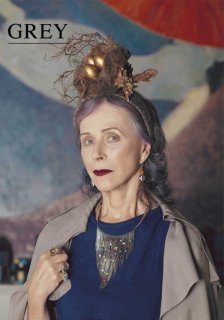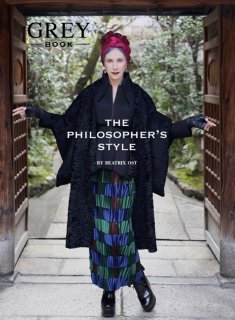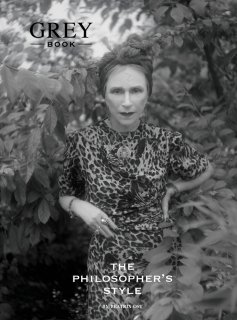Outré, yet Uncontrived
By Sarah Sargent
VirginiaLiving.com
From the moment I passed through Estouteville’s gates I felt like I entered a magical realm. Approaching the house, home to Beatrix Ost and her husband, Ludwig Kuttner, I saw a variety of captivating sculptures—great stone spheres, totemic figures, twig structures, witches’ balls, winged rocking chairs and musical instruments—adorning the lawn and hanging from tree branches. More than artworks, they suggest talismans that fulfill a potent spiritual function. I notice two peacocks strutting languidly amongst them; seeing me, they sound the alarm announcing my arrival.
Ost welcomes me into her kitchen. An expansive space that includes an attached butler’s pantry, it’s clearly the heart of the Charlottesville-area home. With its dramatic black and white tiles, it has an old-world charm evocative of some splendid Wiener Werkstatte café. I want to linger in the space, but Ost leads me down the hall into a salon. A large square room, the walls have a sumptuous olive green and gold faux finish. On two long walls, red shelves—contemporary minimalist versions of a Chinoiserie cabinet—hold an extensive collection of German Jugendstil pewterware including a monogrammed plate once owned by the actress Sarah Bernhardt. It is a beautiful room, dark and exotic, evoking a stage set designed by Baskt or Cocteau. I sit on a yellow leather couch. An orange marmalade-colored cat snoozes in front of the fire on large cushions tossed casually on the floor. Ost offers me a dish of Tibetan tea. She and her husband are practicing Tibetan Buddhists and have been dedicated supporters of Tibet for many years. The tea was made by a Tibetan woman who, along with her husband and two children, is staying at Estouteville at Ost and Kuttner’s invitation while they establish themselves in the area.
Beatrix Ost, “Trixi” to her friends, was born in Stuttgart in 1940. In her youth she studied at the Academy of Fine Arts in Munich and with Expressionist artist Oskar Kokoschka in Stuttgart. An accomplished sculptor and painter for many years, her work has been exhibited in Virginia at Second Street Gallery in Charlottesville, the Peninsula Fine Arts Center in Newport News, and at various venues in New York and Germany. Ost is also a film producer, screenwriter and actress. A resident of the U.S. since 1975, she divides her time between Charlottesville and New York City. She has also modeled and acted (in movies and on stage), and is an expert skier and gourmet cook.
Ost is well known for her dramatic personal style. She was identified by style mavens Mary-Kate and Ashley Olsen as the inspiration for their Fall 2010 collection. “Trixi is basically an intergalactic phenomenon that presents in the shape of an amazing woman,” says Deborah McLeod, a curator and gallery owner (Chroma Projects, Charlottesville) who has worked with Ost over the years. “I tremendously admire her approach to the world, which is to understand it as miraculous and to interpret that quality in her art and personal style accordingly.”
On the day of my visit, Ost is wearing a long-sleeved leopard print blouse under a lustrous chartreuse jacket. In a nod to the country setting, she has on a vaguely tweedy brown skirt, heeled oxfords and thick tights. The effect is kind of 1930s, but the choice of pieces is very modern. Her famous blue hair is in a loose chignon and she is wearing her trademark claret-colored lipstick and nail polish. On her ears are gold snake earrings, and on her fingers are the same four rings she always wears; two are her own design of twigs that wrap around her fingers up to the first knuckle, tributes to the Virginia landscape. Kuttner purchased the other two for her in Venice. One, made for the Mexican film star María Félix, features a large pearl entwined by a snake; the other is a memento mori skull.
Ost says her style sense is so inbred she never thinks about it. She insists she is not a shopper, and while I don’t totally buy this, I know what she means. She never throws anything out and wears clothes she’s had for years, augmenting them with the odd newly-acquired piece. Many of her garments, including shoes, are bespoke, designed by herself. Ost favors a late Edwardian style (peplum jackets over long narrow skirts, hats or turbans and ankle boots) but it’s an Edwardian silhouette as interpreted by someone who also favors the more avant-garde vision of say, an Issey Miyake or Comme des Garçons. Despite her outré choices, Ost always manages to look feminine, elegant and uncontrived.
She is amused that she has been elevated to the role of fashion muse. She’s been designing her clothes for years, but was never interested in parlaying her talents into a business. “I squandered my talents in that area, but the day-to-day commercial side of fashion would have bored me.” Ost’s passion was always art. She comes from a long line of artists. “Art was our religion,” she says of her family. “Art was everywhere on my mother’s side—architects, painters. It was just there. It wasn’t a big deal.” Indeed, her maternal grandfather was a painter of some note. His lovely portrait of her mother as a young girl hangs over a fireplace in one of Estouteville’s sitting rooms.
It is only in recent years that Ost has turned her attention from visual art to writing, an endeavor begun as a means to share her history with her children. In 2004, while going through an armoire, Ost discovered love letters written by her father to her mother during World War II and was inspired to write My Father’s House (Helen Marx Books/Books & Co). Ost writes in German and in longhand, subsequently translating what she has written into English assisted by a professional translator. She is fluent in the language, but realizes that a non-native speaker can sometimes miss nuances. The diligence pays off; My Father’s House is beautifully expressed, lyrical and evocative. In addition to being a vivid account of life seen through a child’s eyes, what is most powerful about Ost’s book is that it conveys the humanity that existed in certain quarters within the horror of the Third Reich. Ost found the experience of writing a memoir to be a profound journey where “the story comes out in pieces” with one memory triggering another. “It’s like constructing a skeleton and then layering flesh over it.”
Ost’s father, who detested Hitler and the war itself, was an officer in the army. He served on the front in Bordeaux and was eventually sent to Africa where he was named City and Harbor Commander of Tubruq, Libya. While there, he became friends with Field Marshal Erwin Rommel. During the final conversation between the two, Ost’s father observed that the war was lost—a treasonable offense. Rommel could have had him executed, but instead discharged him from the army and sent him home citing a likely nervous collapse.
Ost was raised on a family estate in Bavaria, which was peopled by a motley crew of family retainers and relatives. Presiding over everything was Ost’s mother, whom she says “had the wonderful quality of not burdening herself with inalterable situations.”
These various influences together with the daily experiences of rural life shaped Ost’s character. She’s someone who takes the long view, is easily adaptable and seems unruffled by life’s quotidian challenges. The circumstances of her childhood also had the advantage of insulating her somewhat from the war, though there were air raids and times when the family would run and seek shelter under a bridge while allied planes flew overhead. In spite of the turmoil and hardship gripping Germany, the childhood Ost describes is mostly idyllic. Her father rejoined the family in 1943, so from the time Ost was three, both parents were present. And being on a farm, with food and shelter, “all that really mattered” was readily available to them.
Ost and Kuttner met in Munich in 1967 at Oktoberfest. At the time, Ost was a young single mother of two boys and Kuttner was just 21. They became fast friends. Over time, their relationship blossomed and after three years they moved in together, eventually marrying. Kuttner adopted Ost’s two sons from her first marriage and the couple went on to have another son together.
Ost and Kuttner travelled to America on the QE II in 1975. They fell in love with New York and decided to raise their children there “out of a sense of curiosity and adventure,” explains Ost. While they maintained an apartment in the city, they purchased an historic house in Cold Spring, New York on the Hudson River. She calls that move “expanding into the American wilderness.” The house burned in 1981. Ost was devastated, and wanting to make a fresh start, she held a pendulum over a map of the eastern United States. The pendulum swung in a wide arc, which grew smaller and smaller before centering over Virginia and then Albemarle County, and finally pointing directly to an area south of Charlottesville. During an exploratory trip they discovered that Estouteville, begun in 1827 by James Dinsmore—a master carpenter who had worked for Jefferson on the construction of both Monticello and the University of Virginia—sat on the very spot where the pendulum had pointed.
Determined to live there, they approached the owner, J. Prescott Carter, about buying it. He was amenable, but insisted they wait until after the death of his wife, who was ill at the time. After Mrs. Carter died in 1983 and the sale went through, Ost and Kuttner went about restoring the house.
Built for John Coles (an Albemarle County merchant, farmer and intimate of Jefferson’s), Estouteville’s grand scale, perfect proportions and superior workmanship rank it as one of Virginia’s architectural gems. Thought to be influenced by Montpelier, the brick house has a double façade with substantial Tuscan porticos on either side. The gracious center hall, arguably one of the stateliest rooms in Virginia, features a stunning Doric entablature of ox-skull metopes that encircles the space. Off the hall, which the Coles called a “summer living room,” there are two symmetrical sitting rooms in front, and a transverse corridor containing two graceful mirror-image staircases in the rear.
Ost and Kuttner, a developer and the former CEO of Hampshire Group, Ltd., a holding company that markets apparel, have filled Estouteville with their considerable collection of mostly early 20th century antiques and decorative arts. In addition to significant pieces by Michael Thonet and Josef Hoffman, the hall is appointed with daring contemporary designs: One of the famous Droog bureaus made from found drawers lashed together with a cable is at one end, and a large circular bronze table with attached bench by Michele Oka Doner is at the other. Lined up against one wall is a collection of unusual antique children’s chairs, and on the walls are works by Ost and Shelia Metzner. This wonderful pastiche of 20th century art and design might needle some purists who would prefer to see Estouteville frozen in a 19th century time capsule, but somehow it all works, breathing life and character into the grand old house.
Beautiful as it is, Estouteville is very much a family home. There is the reassuring accumulation of clutter, and everywhere there is evidence of children. Ost is a devoted mother to three sons and has eight grandchildren.
She has recently completed her second book, More Than Everything, set in the 1950s and ’60s, which covers her life as an art student and first marriage to a brilliant, but troubled, South American writer. Next on the docket are a series of short stories, and there is always the call of the visual arts to lure her back into the studio.
Open-minded and full of energy, she doesn’t discount anything. Indeed, Ost seems remarkably at ease in the world and, most important, with herself. “In your body is a good place to be” is a quote that is rendered in mosaic tile in the bathroom of her New York apartment. Unquestionably an “old soul,” she doesn’t sweat the small stuff, but chooses to focus on what really matters: a heart and mind fully engaged with the world around her. How she dresses, appoints her houses, creates her art, writes and comports herself are all part and parcel of a whole infused with joie de vivre.




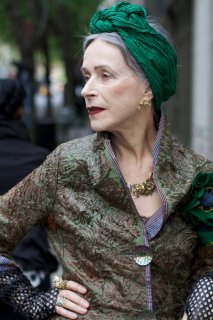
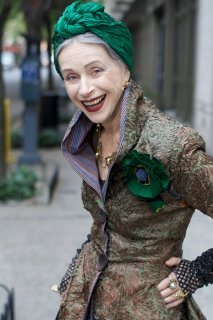
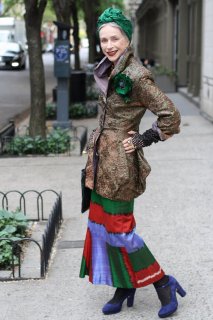





























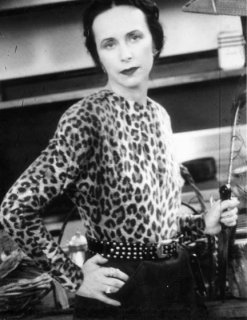
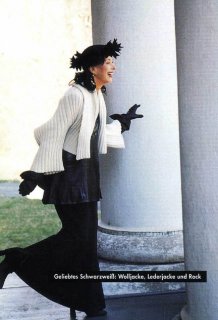
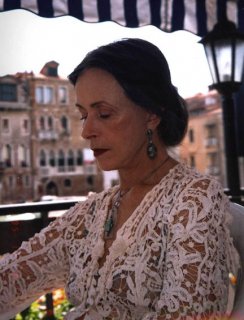
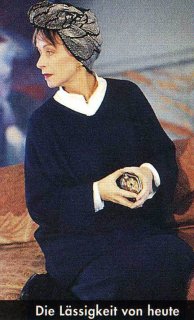
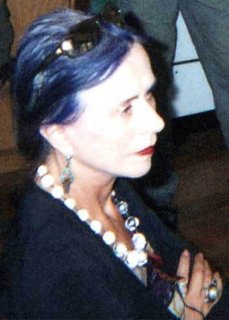










 .. thank you, meidude, wish there were more than just two shots of her in that story, she looks far more interesting than Chloe. Not sure I'm feeling that deeper shade of blue but it certainly works for an editorial.. you'd hardly believe it's her actual style magnified.
.. thank you, meidude, wish there were more than just two shots of her in that story, she looks far more interesting than Chloe. Not sure I'm feeling that deeper shade of blue but it certainly works for an editorial.. you'd hardly believe it's her actual style magnified. 
